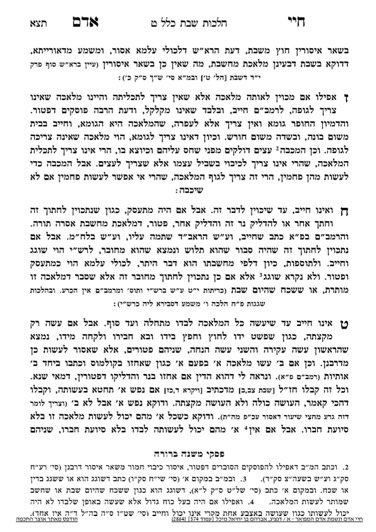We are beginning siman 7, where the Chayei Adam introduces the concept of melacha she’eina tzricha legufa. This concept is unique to Shabbos, and Rashi explains that this unique halacha is a result of the concept of meleches machsheves.
The Chayei Adam writes that, according to the Rambam, a melecha she’eina tzriacha legufa is chayav mideoraysa, unless one is destroying (mekalkel) through the action. However, the majority of poskim hold it is an issur derabanan.
The Chayei Adam next defines melacha she’eina tzricha legufa. He writes that melacha she’eina tzricha legufa is where one performs melacha with full intent, but does not need the primary outcome of the melacha. There are actions in which we can isolate the melacha element from its outcome. For example, if one digs a hole for the purpose of the dirt rather than for the hole, the melacha is still chofer (learned from choreish), creating a usable hole, but in this case, there is no intention to use the hole. (The Chayei Adam qualifies that if one digs a hole in their home, the chiyuv is boneh [because they are digging to build something in their house], and in a field, the chiyuv is choreish [because they are digging to plant].) In both cases, the primary purpose is to use the hole, whereas, in this case he has no use for the hole. Thus, the purpose of the melacha in this case is different from the normal melacha.
Over here, where there is no need for the hole, the melacha associated with the action (creating an usable hole) is not relevant to the person, and at the same time, they have intention for their action ( making the hole) since they need the dirt. In the Gemara, Rav Yehuda holds that melacha she’eina tzeicha legufa is chayav, because the action itself is problematic, even if its purpose is different. Rav Shimon disagrees, and holds that melacha she’eina tzricha legufa is patur.
This halacha is unique to Shabbos, and only because of the concept of meleches machsheves. The melacha’s chashivus is undermined by the fact that the melacha is not performed for its primary purpose. In the rest of the Torah, the person has intentionally done the action prohibited by the Torah, and his motivation is irrelevant.
Nevertheless, it is assur mederabanan. The Ran adds that it is a chamur derabanan, because it parallels the issur deoraysa so closely. Therefore, the Ran concludes that we are more machmir on it, because of the concern it will be confused with the issur deroraysa. We follow the majority of poskim, who hold melacha she’eina tzricha legufa is assur miderabanan, not like the Rambam who holds it is deoraysa.
Summary
- Melacha she’eina tzricha legufa is a melacha performed with the proper intent for the action, but with intention for a different outcome than the melacha’s normal primary outcome. Therefore, the majority of poskim hold it is not assur mideoraysa, because it is lacking in meleches machsheves, but rather assur miderabanan.



